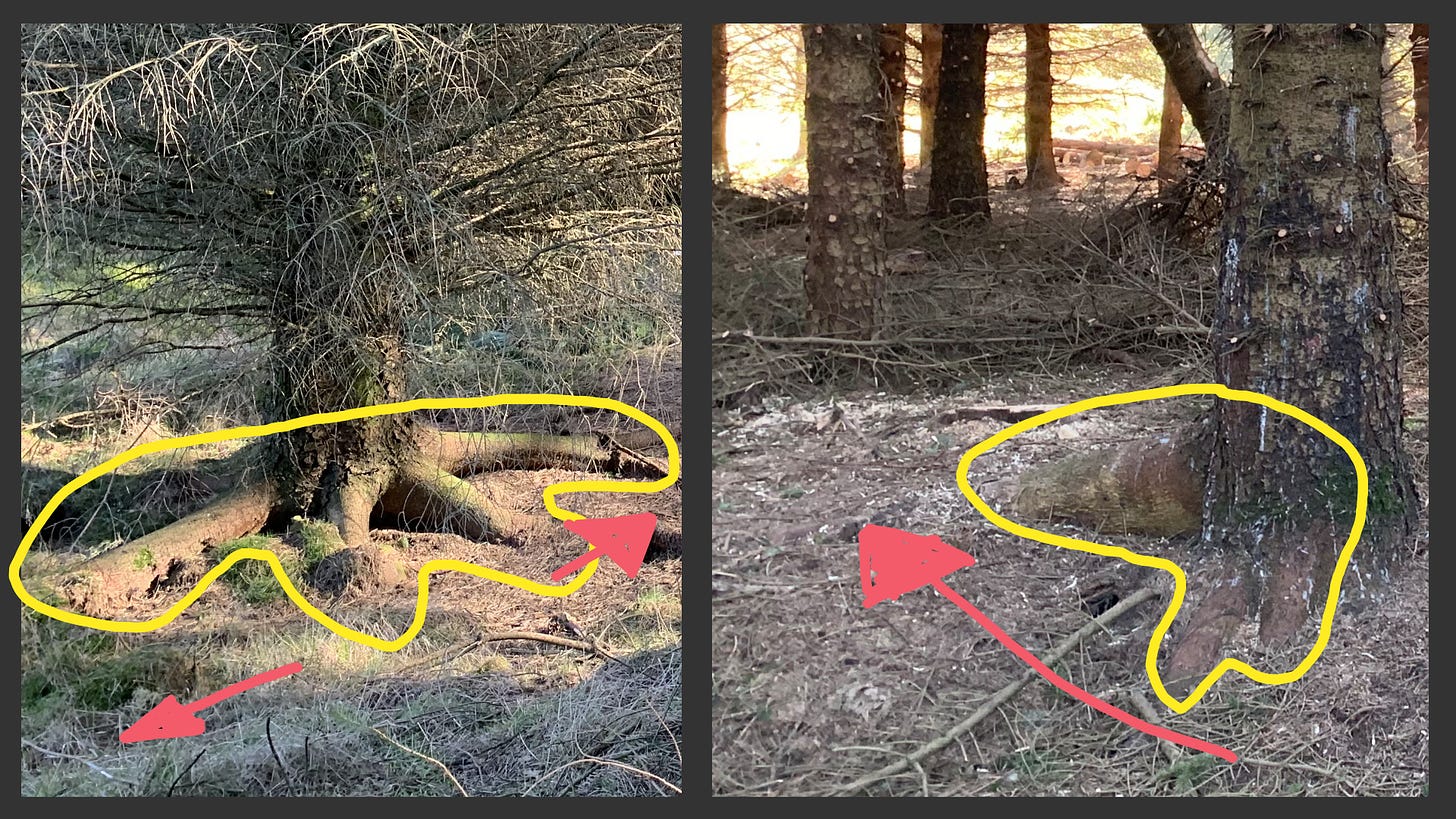The main bits of trees and what they do.
I am delighted to report that after a year at treeschool I have learned that trees have three main bits. Not only that, but I've learned their names and how they work.
note: I’ve written and rewritten this many times. I started it in mid-April. I keep doubting myself and find parts that are not technically correct so I hold off and re-write it. I imagine being chastised and corrected by internet experts. Imposter syndrome is the term for it. The thing with imposter syndrome is that whilst it feels awful, and it almost certainly means that you’re not actually up to the level you think you are, it has one very useful upside. It lets you know you’re on the right track. So I’m hitting the f**k it button and just letting this post fly.
At the very least this post will serve to capture my understanding at a point in time. Please feel free to correct me in the comments.
It is an accepted truth that there are three main bits to a tree. There’s the bits above ground, that would be the trunk and the crown and then there are the roots which are below ground. However, there is a lot going on in those three bits and I wanted to write a shortish piece covering the main purposes of each bit and quickly cover the main biological processes that bind them into a single life form. I’m going to make some deliberate omissions and tell some half truths in the vein of making things easier to digest. Unintentionally, I’ll likely miss some obvious things as a result of the fact I’m still mentally mapping treeworld out. I’ll fix any errors in the future.
Defining what a tree is, is deceptively complex but I’ll take a poke at it.
“A tree is a living stick capable of photosynthesis”
Jamie Curle 2023.
Allow me to expand on this quality definition.
Any part of the tree that is green, especially the leaves, is capable of photosythesis. As you’ll probably know, photosythesis is a process which generates glucose (fancy pants term is Gluconeogenesis) from light, water and carbon dioxide. The glucose produced by photosynthesis is the primary fuel that the mitochondria in each living cell use to create the energy required for life. The less wordy way of saying this is that a tree uses glucose to aerobically respire. Fun fact - humans use the exact same process and get their energy in the exact same way, only we ingest food so that we can generate glucose. The main difference between humans and trees is that trees use carbon dioxide as their input for their respiration and output oxygen. Humans require oxygen as an input and we output carbon dioxide. That’s a match made in heaven if ever there was one. Almost as good as crumpets and butter.
However, being a stick capable of photosynthesis presents certain challenges. First of all you have to ensure that you can reach the sunlight by having the largest stick. If you don’t have the largest stick, then you will probably die, hence you need to be constantly growing, which requires energy. Not a problem because the stick can photosynthesise, generating the materials for all the energy it requires to be taller than everything else. Secondly, however, the taller you are, then the more force you catch from wind. If you catch too much wind, you will be pushed over and die. Not a problem, as the stick also devotes energy into growing into the ground for support. Thirdly, you have to deal with time, seasons, weather, predators, pathogens, humans, fire, thermodynamics, chainsaws, axes, covid-19, reproduction, genetic mutations, fire starting youth1 and a list of other things that I don’t care to mention.
In essence, a tree has 99 problems but glucose ain’t one. That’s why I’m writing this, because each of the three bits, either alone or in concert with one another, does one or more things to defend against these “99 problems” and frankly it’s amazing that trees exist.
I’m going to drop the “living stick capable of photosythesis” idea. It wasn’t very good. It was a little funny, but it is practically useless. I promise not to send you to sleep though. So, the science… just kidding. Let’s start at the top and work our way down but before I do, let’s make a distinction now so I can avoid getting tripped up by it later.
Broadl(eaf)y speaking there are two types of trees. I’ll spare you the angiosperm / gymnosperm, evergreen / deciduous and instead use the more accessible concept of conifers and broadleaves2. Conifers keep their foliage all year round and broadleaves drop their leaves in winter3. I’m not getting into that here, but what I will get into is the amazing fact that conifers and broadleaves both evolved independently and arrived at the same “tree” conclusion. That fact alone blows my mind. It’s the evolutionary equivalent of watching two people rock up to a party thinking their dress is unique to them, only to find out someone else is in the exact same dress. Awkward. Men don’t suffer from this issue. We wear suits.
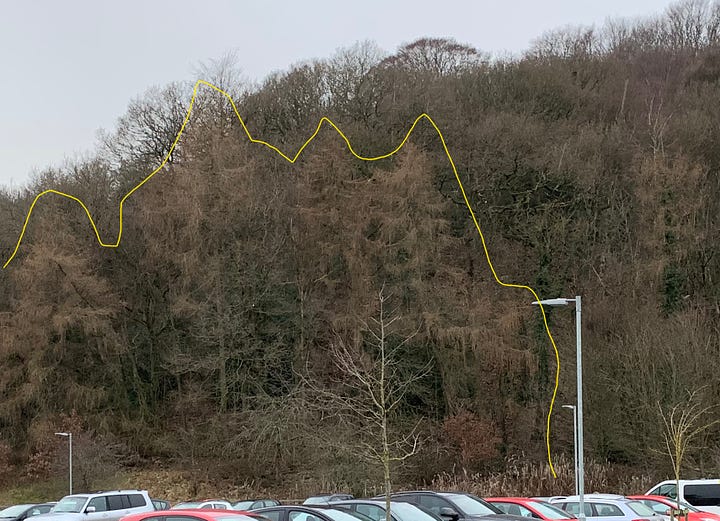
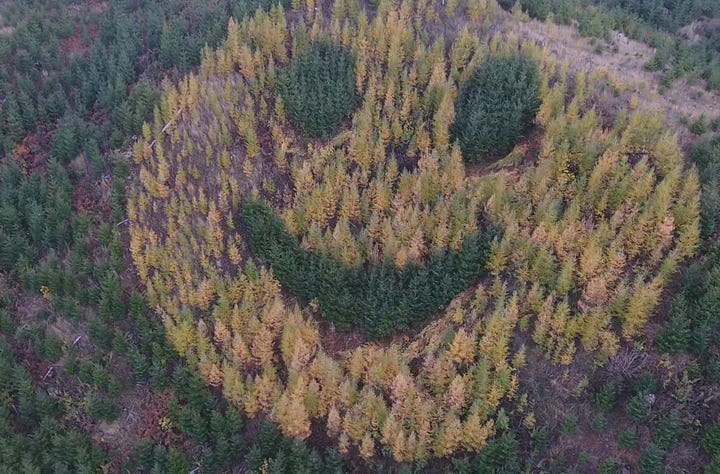
1: The Crown
Like most fields in the world, tree people don’t agree on some things. Some people call the crown the canopy and others insist that a canopy is a plural form of crown that applies only when the crowns touch or group together. I bet these people are never invited back to dinner parties. I’m going to use the term “crown” but I really don’t care if you say canopy. I may be a little snobby, but a pendant I am not. There are three important things going on in the canopy; foliage, flowers and fruit. Glucose generation, energy production, reproduction and distribution all take place in the crown over these three parts.
Foliage
The crown is where the foliage lives. I’m using the term foliage, but in conifer world that could translate into “sprays” (e.g. Thuja plicata - western red ceder) or “needles” (e.g. Pinus sylvestris - scots pine). In broadleaf world foliage would mean “leaf” (e.g. Quercus robur - english oak). It’s just easier to say foliage.
Needles and sprays are fascinating things as they allow a conifer to photosynthesise in winter (albeit at a very reduced rate) but they defend themselves against sub-zero temperatures by deploying their own version of anti-freeze in their resin. The design of a needle (and sprays to a lesser extent) is also pretty aerodynamic which assists in minimising the sail effect in windy periods. This helps the “stick capable of photosynthesis” remain upright.
Leaves are equally interesting. Each species of tree has optimised the design of its leaf to account for wind. You read that right, each species of tree has evolved in such a way as to minimise the sail effect caused by the wind. Broadly speaking there are three categories of leaf design (simple, complex and pinnate), although in practice there are many categories.
Basic leaves are basic such as Alnus glutinosa (common alder, picture on the left below) or Fagus sylvatica (common beech). When people think of leaves, they typically tend to think of this kind.
Complex leaves like those found on Liriodendron tulipifera (Tulip tree, pictured below right) or Acers (maples). Complex leaves are those that have multiple points to them. Norway maple, sycamore or any maple is the examples usually described, but amazingly I didn’t have any photos of my own and I’ve reached my threshold for using 3rd party images.
Finally we have pinnate leaves such as those pictured below in the middle on the Sorbus aucuparia (rowan) tree. Pinnate leaves are collections of leaflets that make up a leaf. In the rowan example below, there are four leaves in the foreground. Each leaf is made up of approximately eight leaflets. Leaves, and describing leaves is a big thing and a post for another day. To give you an example of overly verbose leaf-speak, I could describe the rowan leaf as being “a pinnate leaf made up of 8 or more individual leaflets that are of an elongated simple shape with serrated margins”. Super wordy, super nerdy.
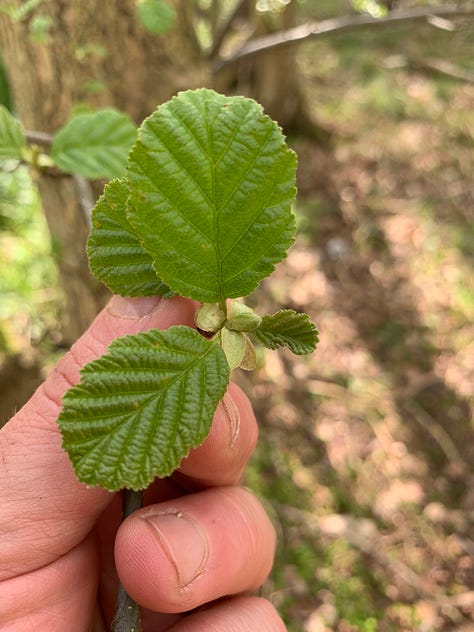
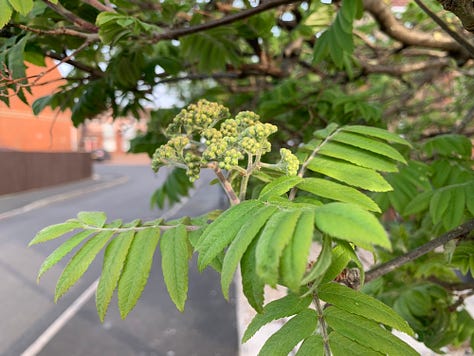
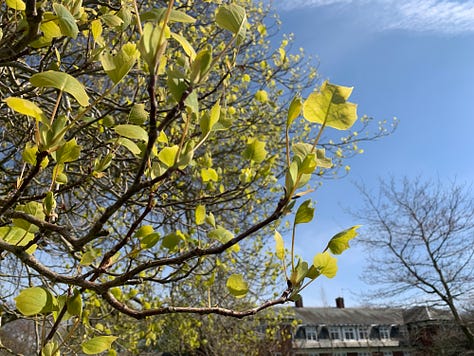
Foliage also contains “the sexy reproductive bits”. To be drastically simplistic about matters this translates to flowers, catkins, cones and fruit. There is a LOT to unpack in this topic, so I’m skipping it entirely. Another post for another day. I’ve tried to summarise flowers, catkins, cones and fruit a few times when writing this, but each time I end up inserting about a 1000 words and it never stands up to any basic rigour, so I’ll do that later. What I will say is keep your eyes open in the next few weeks as the Sorbus genera starts to flower. Sorbus aucuparia (rowan- pictured above you can see the flowers just starting in late April), Sorbus aria (common whitebeam) and Sorbus intermedia (swedish whitebeam) are of particular note. They always seem to mark the start of both summer and two months itchy red eyes.
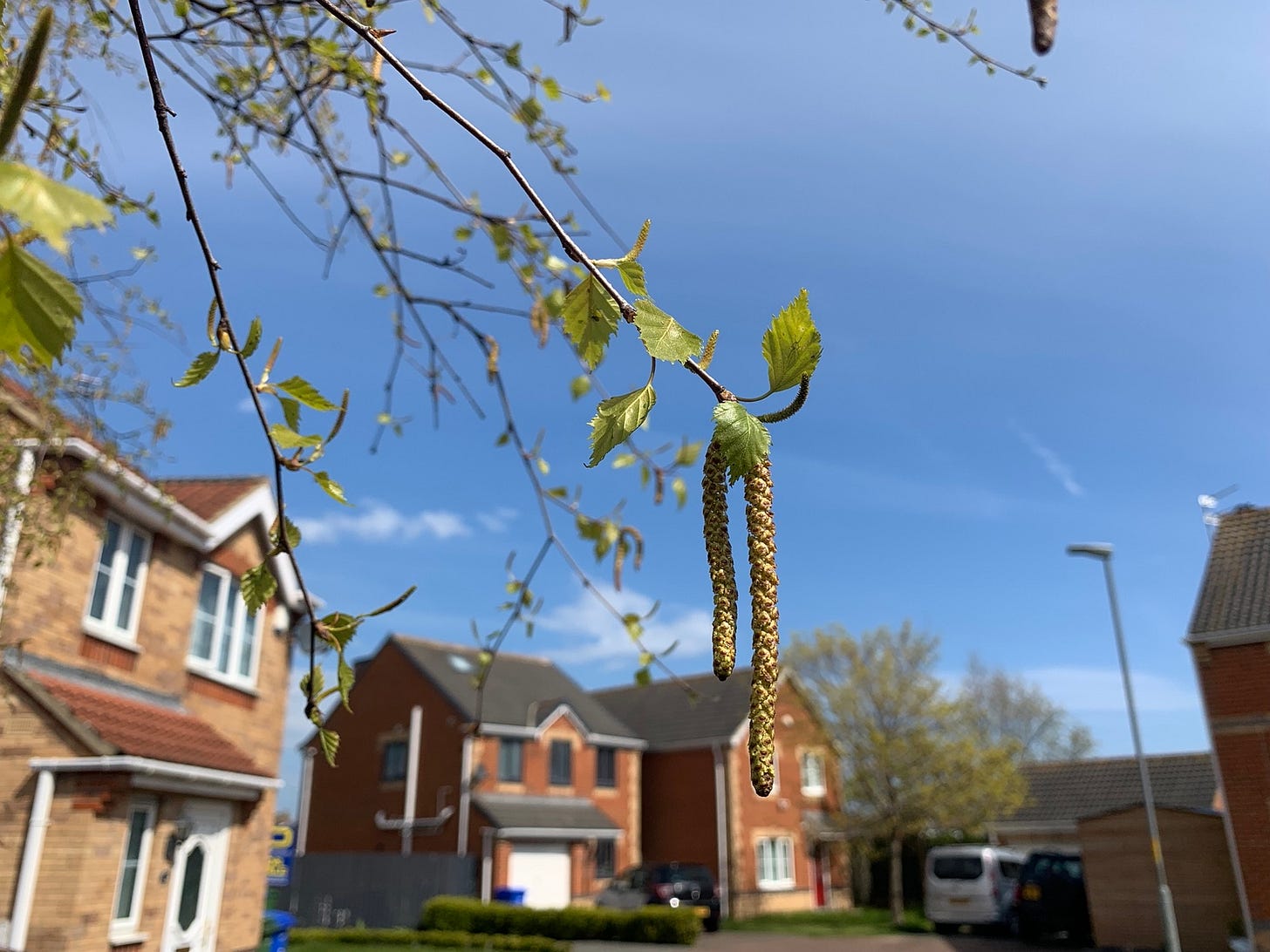
Time
Trees respond to time. As much as I’d love to write about everything from the perspective of a season, that’ll be another thing for another day. But I did want to get autumn in this section because of the impact on foliage. The irony here is that I edited out a massive section on spring, which would have been much more relevant given the time of year it is now.
So now that I’ve ruined your day wishing away summer, let’s imagine it is the end of September and the days are shortening. Shorter days mean less sun. Less sun means less glucose production from photosynthesis in the leaves. Every living cell of the tree is continually producing an invoice that the the tree must pay. As soon as the tree detects that it cannot keep up with the payments, it does what any rational enterprise does - it get rid of the cost centres and gets ready for a rough ride on minimal rations.
Leaves are an expensive business, so the tree issues the order to sack the leaves. Technically, the sneaky tree already knew it was going to do this. There are a layer of cells where the leaf stalk meets the branch called the abscission layer and they’re like a dead mans switch. The switch is continually held down by a continual level of a hormone called Auxin. It’s complex, but the headline is that when temperature drops to a certain point so does auxin levels. Eventually auxin hits a low-tide mark and this triggers the abscission cells to start elongating. Eventually the cells get so long that they break, and the leaf falls. 🤯
As each leaf drops, a wound is left that must be healed. Nothing is free of charge in treeworld and fixing that wound requires energy. Thankfully, the sneaky tree figured out how much energy was needed to seal each of the thousands of wounds left where it severed a leaf as part of its mass redundancy plan. Once sealed a scar is left on the branch. Unsurprisingly it is called the leaf scar.
In the case of Aesculus hippocastanum (horse chestnut) the shape of this scar may be the origins of the name of the tree due to the horse shoe shaped scar that the leaves leave behind.
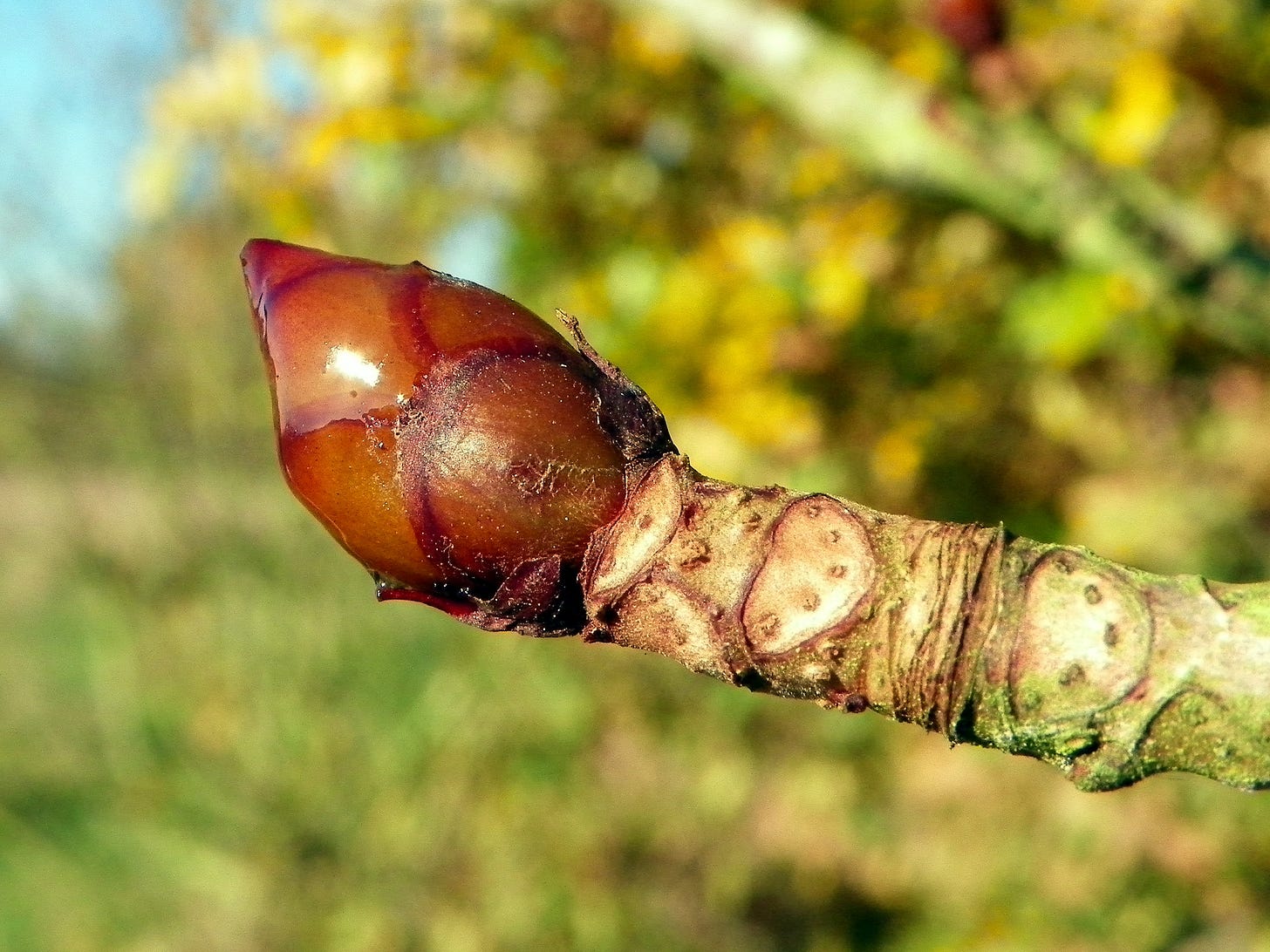
Also note that the bud containing next years leaves is already formed. This is wise from an energy point of view as it is now ready for spring. All it has to do is wait until temperatures hit a high-tide mark so that hormones can trigger the signal “GO GO GO GO” to the tree. Previous to treeschool, I always thought that buds formed in spring. But they don’t. Buds are formed in summer with all the abundant energy, before the tree enters the dormant period. Mind blown again 🤯 .
As autumn turns into winter, conifers slow down. They don’t drop their needles or sprays like broadleaves do. I mean, they do, but not on the same scale as broadleaves. Conifers tend to just dump their foliage so that they retain enough of it to get exposure to the low winter sun, without having to pay the energy bills for foliage that doesn’t get light. They also drop older stuff. Dormancy, winter and conifers is a complex area and once again, I’ll write more on that in a while but below is a photo from my back window showing the effect on Pinus maritima var nigra (Corsican pine). You’re looking at it from behind. The sun passes in front of it, rising in the left and setting in the right. I’ve guessed the winter arch of the sun as best I can but note how the area in the coral scribbles contains no needles. This area would have received light until the houses were built, but now they don’t. Hence, it removed the needles from service.
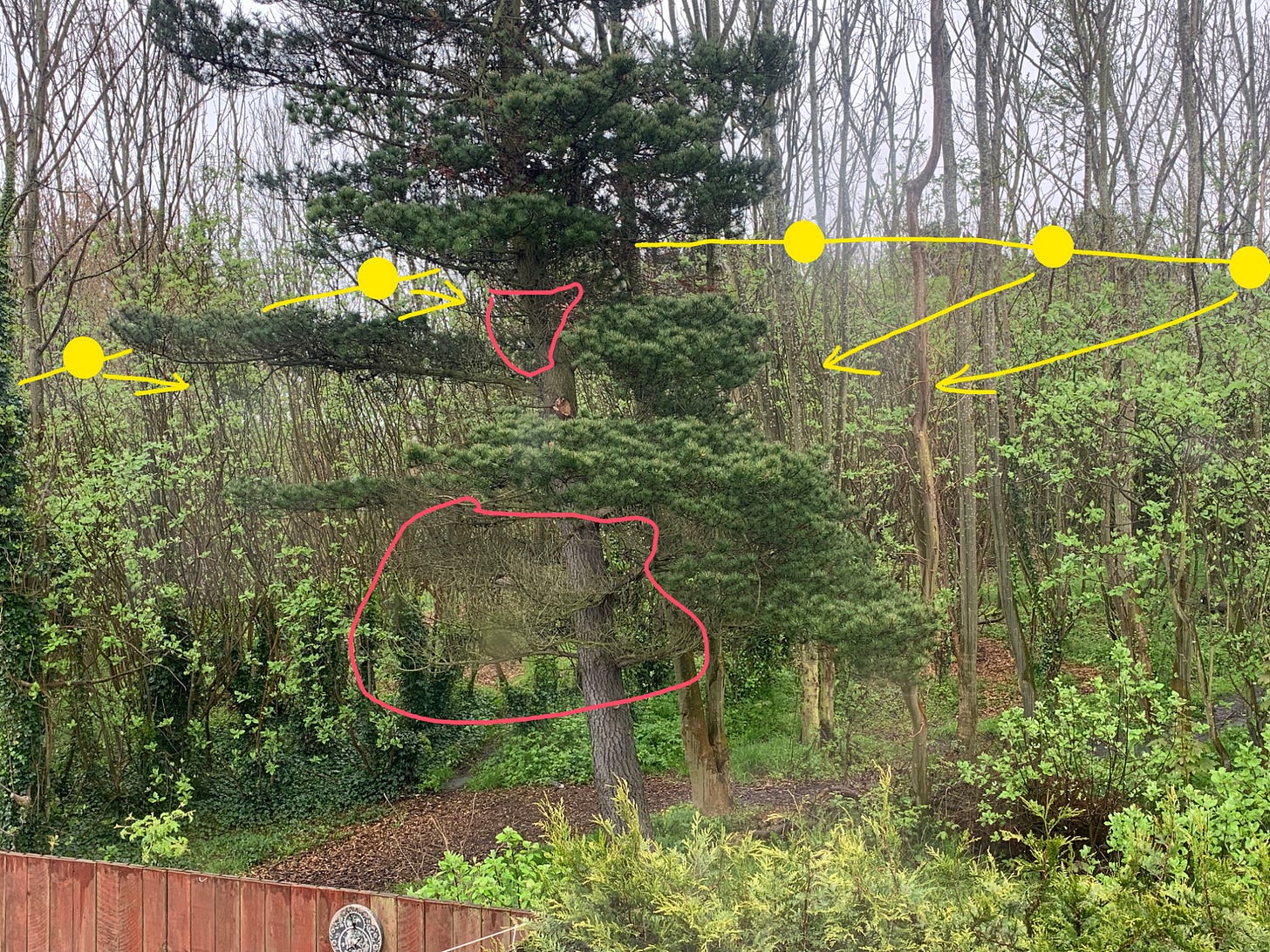
2: Roots
Trees connect themselves to the earth using their roots. These roots originate from the base of the stem and splay out over a large surface area. Generally speaking, root systems typically tend to favour spreading their roots out for maximising horizontal distances rather than going deep onto ground. It is said that most of a trees roots can be found no more than one metre beneath the top soil. I always thought that roots went as deep as the height of a tree. A few species do, but most don’t. I found this a bit terrifying as this knowledge seems to indicate they’d fall over easier.
Depending on what you read, and when it was published you may get reference to two types of root or three types of root. The first type is referred to as lateral roots and these spread outwards. Depending on species and local conditions the exact distance varies but it is typically always beyond the spread of the crown. The second kind of roots are called heart roots and these collectively grow downwards into the soil. The third kind of roots are called taproots and typically a tree only has one. Not all species have taproots but when they do they are big structures, typically mirroring the trunk in terms of dimensions. Here’s some video footage of John from farmcraft101 discovering why a tree won’t fall over despite having the 3/4 of the root plate severed, removed and dug out to a depth of four feet (hint: taproot). I’ve linked to the right part of the video so you can just press play.
Perhaps this is why taproots fall under the category of heartroots in some textbooks? Because not all species have them, I’ll look at at tap roots in the future. Clearly root growth is complicated. Below are two photos from uprooted trees. One is from my woodland and one is from Chopwell woods in Gateshead. Notice the lack of taproot?
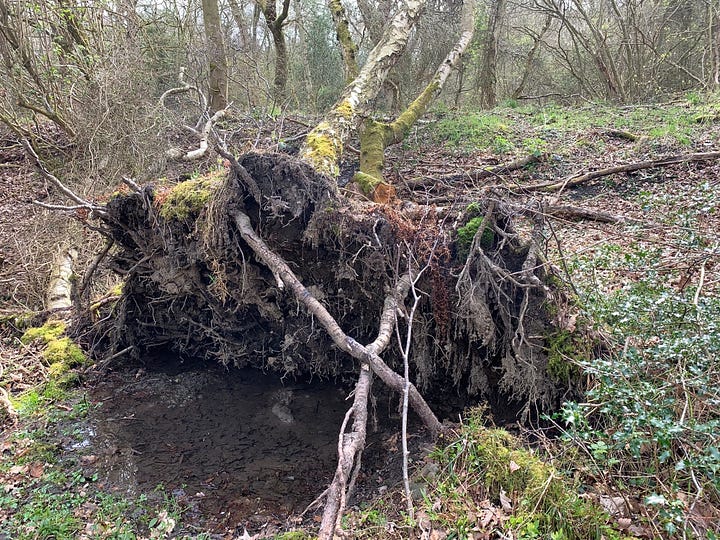

Roots are complex things but broadly they have two main functions. One; making sure the tree doesn’t fall down, which is called anchorage. Two; water and nutrient uptake.
Anchorage
Root systems are engaged in a life long relationship with gravity. Roots anchor a tree and stabilise it against the pulling forces of winds and the mechanical forces of the crown, trunk and branches. Most of the time the roots win and the tree remains upright. Sometimes though, the roots fail and the tree is blown over. This isn’t necessarily a bad thing, either4.
Learning from local conditions
Trees sense and respond to the forces upon them from weather and their own structure. Biomechanics is a topic we don’t cover in treeschool until second year 2023/24, but as far as I am aware the response of a tree to these forces is called geotropism (please feel free to correct if I am wrong). If you look at a base of some trees you’ll be able to see geotropism in action in the form of buttress roots. Below are two examples from the pine woodland that we have been thinning at treeschool. My yellow scribble outlines the buttress roots and the coral arrows show the direction of the forces that the tree was defending itself against. Buttress roots are the tree evolving resilience to the local environment.
For those of us in the UK you may be able to remember Storm Arwen in 2021. It caused a tonne of damage to UK tree stock. Whilst the force of the wind was obviously a factor, the main problem we had in the north east of England was that the storm was blowing from the opposite direction to the normal prevailing wind. Our trees hadn’t been “trained” to handle wind from that direction and so lots of trees failed completely.
Some trees didn’t completely fail in Arwen but instead got new jaunty angles. The below trees from the woodland at the back of my house used to be vertical. The orange line shows where the stem used to be at the start of November 2021 and the yellow line is was after Arwen. In both cases the root plate has lifted up, but the wide, shallow horizontal roots held up and the tree survived. As a response to this stimulus, you can bet your bottom dollar the below trees have since grown new roots in response to their new mechanical predicament. Next time that north wind blows, these two should be prepared and it’ll be another check in the box for Hans Selye’s idea that “what doesn’t kill you, makes you stronger”5
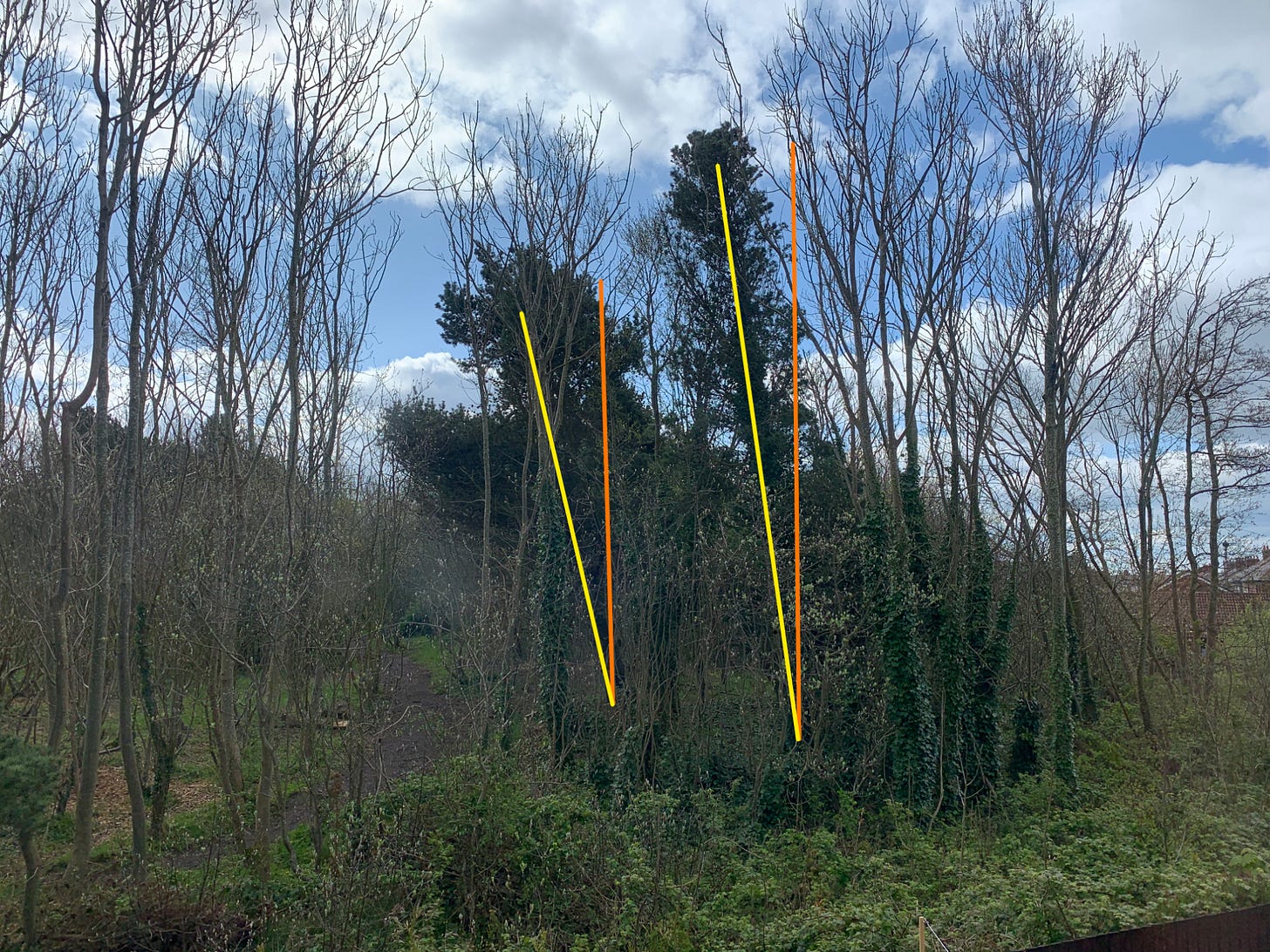
Interestingly, most of the ash trees that surround the above pines didn’t move at all. This has something to do with the crown. Can you guess why most of the the ash trees didn’t move?6
Water & Nutrient uptake
The second main function of roots is nutrition. Just as branches in the crown fork and become smaller towards the tip, so do roots. Instead of leaves they develop tiny hairs. The smaller the root, the more the hairs. The hairs are very small. Single cell kind of small. These hairs nestle themselves between the soil particles (clay, sand, silt and organic matter) and in doing so they are able to absorb (via osmosis) water and along with the water, available nutrients. The main nutrients required by trees are nitrogen, phosphorus and potassium (more commonly collectively referred to using their periodic table references of NPK).
Just as humans store excess energy for later use, so do trees. During summer7, when trees are cranking out maximum amounts of glucose via photosynthesis, they convert excess glucose into starch and store in it their woody tissue. The exact location of this storage is another future topic, but broadly speaking it is stored (but not completely) in roots. When I speak of nutrients, I also include oxygen in that definition. Roots need oxygen also as it is a critical input in the photosynthesis process. Yes, leaves intake oxygen but so do roots. This is why soil compaction around trees is an issue.
Soil is a big conversation, but it is made up of three main things, sand, silt and clay. Sand particles are big, silt particles are small and clay particles are the smallest. Generally speaking you want a mixture of all three, which generally translates into “a nice loam” in plantworld. The spaces in between the particles are called “the pores” and it is in these pores that water and nutrients exist. Worms and other creatures living in the soil ensure that the soil is maintained in an aerated state with nice pore structure. How kind of them. Upset the balance of the soil and you have issues. Too much water, too much compaction (vehicles or by feet) or any one of another hundred variables will all affect the roots.
Trees are essentially a giant hydraulic system that works with the main system pressure coming from the movement of water, and nutrients coming up the roots, through the stem and out through the leaves. Again, this is a massive over simplification, but it is a great segue into…
3: Stems & Branches
Just as roots have two main purposes, so do the stem and the branches. The first is provide the plumbing for the movement of water, nutrients and sugars around itself and the second is structure.
Movement
The movement of water and nutrients through a tree is called “transpiration”. I’m trying very hard to not go all textbook on you, but I need to lay down some names here. In a very basic sense there are two kinds of “vascular” cells in a tree. Xylem vessels and phloem vessels. Xylem vessels are found in the wood of a tree and they transport water and nutrients upwards. Phloem vessels are found on the outside of the the cambium layer in between the outer bark. Some textbooks refer to phloem vessels as “inner bark” which is helpful when dealing with the concept of xylem and phloem at a basic level. Phloem vessels move sugars and other nutrients around a tree. This is a very basic analysis, in reality it is more complex, varies from species to species and is dependant on age.
Side note: It is very easy to kill a tree by severing the thin layer of phloem vessels all the way around the trunk. This is why damage caused by rabbits, deer, squirrels and voles cause real harm to woodlands. They all eat the inner bark as a means of getting food.
Here’s some examples from the trees at treeschool.
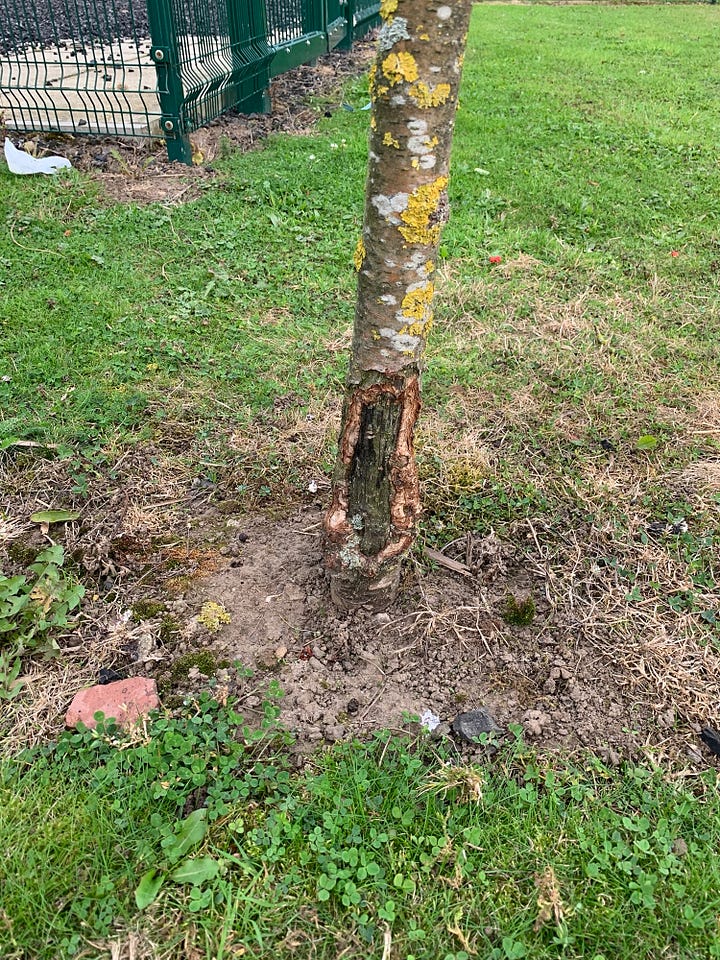
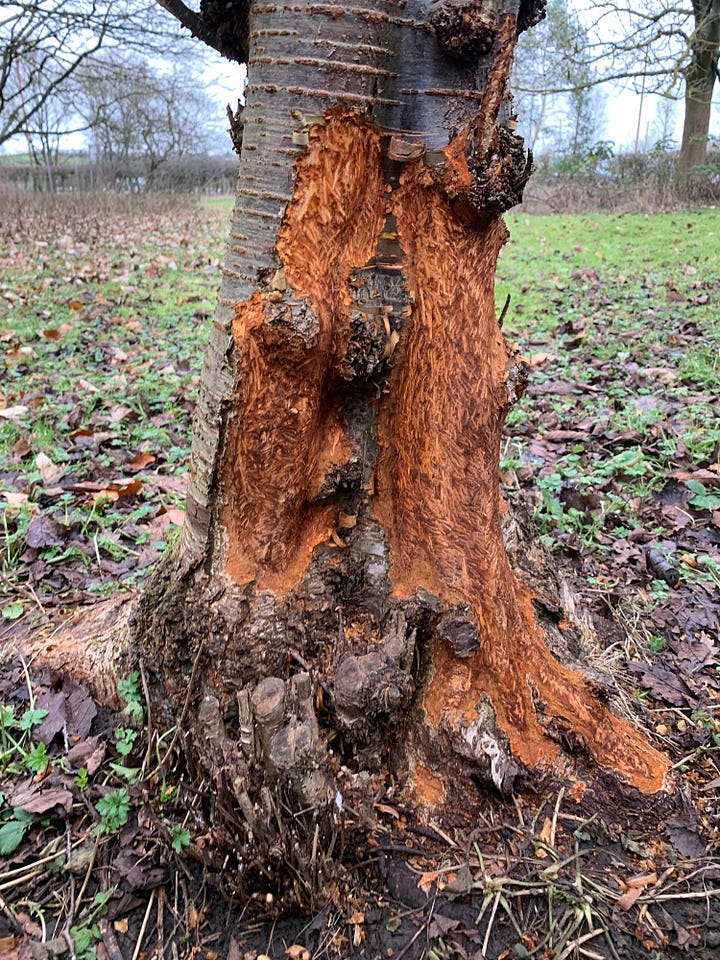
Ok, back on track - movement of water, nutrients and sugars. In a lot of respects the stem and branch tissue is exactly the same as the root tissue aside from a few key differences. Above ground we have the corky outer bark, which acts as a protective coating and below ground roots have root hairs. There’s little difference in the function of movement of water, nutrients and sugars through the tissue.
Structure
Trees grow vertically into the air by adding height to their stems and grow horizontally by branching outwards in the search for light. Some species such as Betula (birch) demand full sunlight and will fiercely complete for height, where as others such as Acer (eg maple species such as norway maple and sycamore) will happily crack on in semi-shade89.
Branches have to deal with gravity on a full time basis. Gravity demands a toll from every kilogram for every second it is in the air and the tree has no option other than to pay. Some species handle this fine, and create structures that have no business standing up. Such as this branch on birch tree from our woodland.
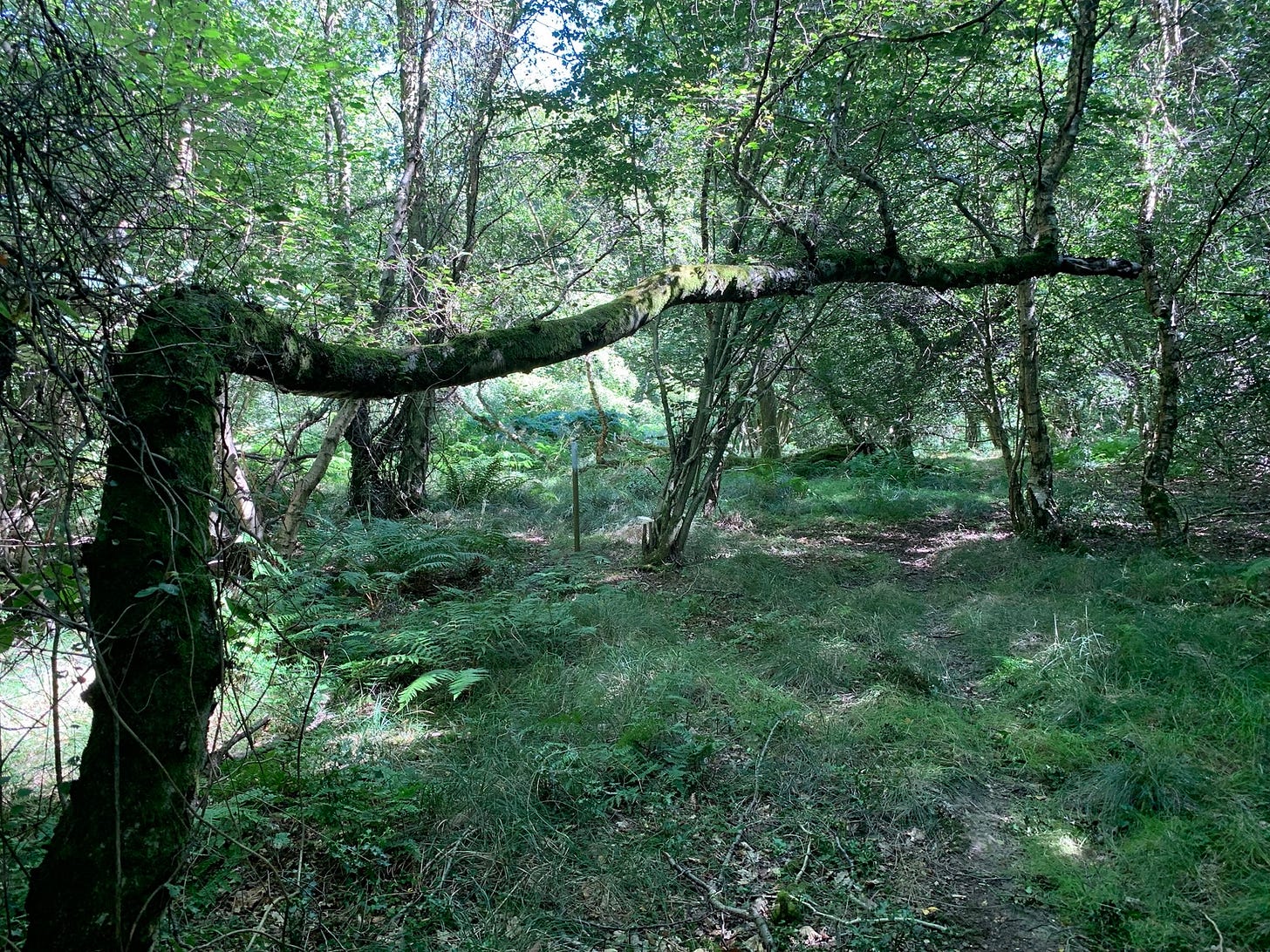
Some genera (fancy pants term for groups of species) of trees write cheques that their stems and branches can’t cash and are quite “splitty and snappy”. Salix (Willow) and Populus (poplar) are both examples of species that like to split and crack. Salix fragilis (crack willow) actually gets its name from the fact that it loudly and regularly cracks under its own weight.
Some genera such as Fraxinus (Ash) and Fagus (Beech) will actually shed large limbs at will. This is why it isn’t wise to camp under a beech tree or park a car under an ash tree. Here’s a video of a UK treeworker going about his business fixing up some issues in a beech tree, when all of a sudden, the tree decides to self-prune a massive limb. As with the taproot video, I’ve linked directly to the juicy bit.
Beech trees can be especially weird in the sense that if they are left alone, with no competition they’ll often grow big enough that they cannot handle their own weight. Whether this is a propagation strategy (beech will grow roots readily when bark is exposed to soil) I am not sure, but whatever it is, think twice before planting a lone beech tree in a site with plenty of space.
Wrapping up
Lessons learned…hmm.
One, trees have three bits and they are really complicated to explain beyond the generic basics. Don’t think of trees in three bits though, they are more than the roots, the stem and branches and the crown. Trees are living things and we humans have a direct relationship with them. Our existence depends on them and to some extent, their existence depends on humans. Trees have evolved in so many ways. We see basics like broadleaves and conifers, but what about the specifics of species such as Quercus robur (common oak) and then what about the specifics of the 800+ species of life that they support? Drilling down either further why are acorns even a thing? What specific set of evolutionary traits yielded that design? How come the two major oak species in the UK; Quercus robur and Quercus petraea are weirdly opposite? One has a stalk on its leaf but no stalk on the acorn (petraea), and one has no stalk on its leaf but has a stalk on its acorn (robur). There’s enough here to keep writing for the rest of my life and even then we’re missing the obvious - wood and wood products. Trees in many way transcend their physical tree forms by being turned into buildings, furniture, tools, fuel to name a few. I may as well top this of by stating that the universe has no edges.
Two, writing this was hard. Way harder than it should have been but at least I’ve now given myself a load of future jumping off points.
I hope it’s given you some food for thought.
If you think I’ve earned it, give it a like :)
Cheers,
Treejamie.
Homo sapiens ‘pyromanicis’. A separate cultivar of humans. Prone to reversion around twenty years although some do manage to retain their pyromaniac ways for all of their life. More common in low income areas such as the authors current home town. Typically found on beaches and public woodland. Cannot be reasoned with.
Important to note that angiosperms / gymnosperms, broadleafs / conifers, evergreens / deciduous, hardwood / softwood definitions all attempt to do the same thing to distinguish the two broad types of tree, but each term has its own specifics. You may try and use them interchangeably but understand two things. One, there is always a pedant waiting to correct you if you get something wrong and two, they are not interchangeable terms.
If you just thought you were about to leave a comment telling me that Larix decidua is a conifer that drops its foliage in winter and that Quercus ilex is a broadleaf that retains its foliage in winter then I give you a gold badge. Good for you.
Pioneer species we call them. Another topic for another day.
Hans Selye’s work, although he had no idea of it at the time, went on to become one of the backbones of modern (human) strength and conditioning. As I understand it, the current thinking on stress is that the effects of it depend on your perception of it. If you perceive it as bad and being done to you without consent, it’ll harm you. If you perceive it as good and take ownership of the fact that you’re responsible for the stress, then it benefits you.
It is called the sail effect. Ash trees had dropped their leaves when Arwen hit and so the wind just passed through their branches. It snapped a few branches, but that was mostly because they are riddled with Ash dieback.
Evergreens also photosynthesise during winter.
This is one of the reasons why Norway maple tends to be planted in urban contexts. Birch is also planted in urban contexts, but isn’t always a great choice. Birch doesn’t like shade. So if you plant this in a front garden that faces north, or underneath other trees, it’ll fight for light and eventually win. Hey presto, you’ve got a monster on your hands. Give me a call in 2024, I’ll charge very reasonable rates for dismantling, removal of waste and stump grinding.
The subject of urban species choice is something I fully intend to explore at a later point in time as it more than interesting and reveals a lot about how disconnected we have become from the reality of nature. Hence two footnotes in one sentence.



